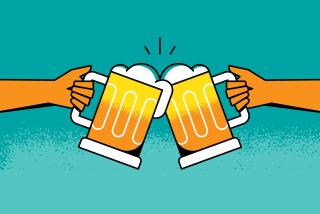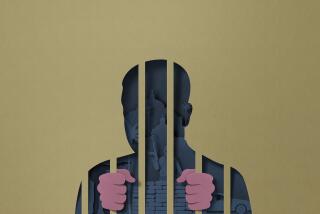Breaking Free of Cocaine’s Hold : Support Group Helps Addicts Arrest Their Drug Habits
Fourteen men and women attended that first meeting in November, 1982. They were a curious mix: a truck driver, an Oscar-winning actor, a personnel executive at a major studio, a secretary, a film director, an electrician and a writer-producer. Most were from the entertainment industry.
What they had in common was that they were all cocaine addicts called together by Tom Kenny, director of the Motion Picture and Television Fund’s alcoholism and drug program. They met in the organization’s Hollywood offices.
What no one in the group could have guessed was that they were the nucleus of what was to become one of the fastest-growing self-help organizations in the country--Cocaine Anonymous.
Today, only three years after that first meeting, more than 2,000 members attend about 70 meetings each week in Los Angeles County alone. Some meetings attract as many as 200, some have a dozen or fewer members. Branches exist in 20 states.
Kenny estimates more than 25,000 members attend weekly meetings and said the number is growing daily. A recent California convention of Cocaine Anonymous members in Palm Springs drew more than 700 people. Another national convention in February, this one for the purpose of formalizing some of the procedures and rules of the organization, will be in San Diego. Delegates from 30 states are expected to attend.
The first meeting was not without problems. Some of those present were members of Alcoholic Anonymous who wanted to launch Cocaine Anonymous under the AA banner. Others favored starting a new organization adapting AA’s program to the needs of cocaine addicts. And it was that attitude that prevailed.
Membership Quadrupled
Within a few months after its founding, the organization saw its membership double and quadruple, said Kenny, who has counseled addictive personalities--chiefly alcoholics--for a dozen years. Twenty meeting places were established in a few months, with secretaries from the ranks of the organization guiding those meetings.
Once the organization took off, Kenny approached personnel directors at various studios and found them very receptive to spreading the word. With their aid, he distributed more than 25,000 “awareness kits” to studio workers, listing the warning signs of drug and alcohol abuse and a phone number to call for help.
It took very little time for word about the new organization to spread to people outside the entertainment industry.
“It was an idea whose time had come,” said Maria, one of the organization’s first members. Beyond that we owe our success to the fact we make no claims about ‘curing’ the cocaine habit. We believe it cannot be cured, only arrested. We arrest it by the simple process of one addict talking to another. No one lectures, moralizes or points a finger. When one of us talks at a meeting, we all know where he’s coming from; we’ve been there. Drug addiction is the only disease known to man where the most effective therapy for it can be provided by those who already have it.”
According to another member, a younger actor named Skip, “Two of the many things that gave impetus to CA was the death of John Belushi and Richard Pryor narrowly escaping incinerating himself. It was Pryor’s accident that brought me around. I read it and said, ‘My God. That could have been me.’ ”
The organization’s Institutional Committee, begun 18 months ago with the purpose of bringing the organization’s message to hospitals and other institutions, now sends a panel of speakers to more than 80 institutions in Los Angeles County every month.
“Hospitals with alcoholism treatment programs have found it increasingly necessary to expand their programs and deal with hard-drug addiction,” said Zeke, a member of the Institutional Committee. “Almost without exception, they have found that while their treatment of the addict is certainly helpful for the 3- or 4-week period the patient is in the hospital, once released the addict is almost sure to go back to using unless he or she has a continuing support system. That’s where CA comes in.”
Striking and dramatic stories are recounted at the organization’s meetings. Paul, a Beverly Hills attorney, spoke of earning $250,000 a year before he quit working. “I lived in a fine apartment with no furniture. Just a bed. I couldn’t afford anything else. I drove a 6-year-old Chevy that I parked two blocks away from the fancy restaurants I patronized. I was being dunned every week by my creditors, by the IRS and my landlord. None of them could understand what I was doing with all the money I was making. I could have told them. I tooted it away.”
Since joining the organization, Paul said, his apartment is furnished, Uncle Sam is off his back and he just bought a new Porsche. “And those are only the minor benefits. The major ones are that I have my self-respect back. I’ve even learned to like myself. Those things you can’t buy.”
While the organization’s focus is the cocaine addict, membership is “open to addicts of whatever persuasion, stripe or color,” said Al, a longtime cocaine and heroin user. “It works for anyone--any addict who really wants it, that is,” he said.
An addict “is anyone who has lost control of his habit,” he said. “There may be a time when a user can snort with a certain amount of discipline. But after a while, for some a very short time, you seem to have no choice; the drug is running your head. You no longer have a choice about what’s happening to you. CA tells us we do have a choice: we can take control again. And no one is hopeless.”
Melinda, a cover girl who said she once graced the pages of many major woman’s magazine, told of earning astronomical fees for her work. But then cocaine began to take its toll and she found herself in less demand. Her savings went along with her reputation. She filed for bankruptcy and a week after that she was a patient in Camarillo State Hospital where she learned about the organization. “I went and it was the best move I ever made,” Melinda said, adding that she is reestablishing her career and feels that she has had a “second shot at living.”
Andy, a rock ‘n’ roll singer, said he once had “three albums in the Top 10. I made more money than I ever dreamed existed. And I went through it--with the help of a dozen or so hangers-on. I blew it all. . . . I lost my wife, my ambition, and mislaid my talent. It’s all coming back now, slowly, but it is. I know it will continue to as long as I stay close to CA.”
‘Roller-Coaster Drug’
Vivian, a woman in her mid-20s, was elected secretary of the first group. It was a job she held for a year. “It was a great learning experience,” she said. “I had used alcohol since I was very young, but I’d only been using cocaine for less than a year. With coke you ride downhill very fast. It’s a roller-coaster drug. With booze you seem to slip much more slowly.
“I was working as a girl Friday to some people in the toy business, feeling more and more insecure, running into deep debt, unable to meet the rent. Then in CA, I was given all this responsibility. Of course, I couldn’t let down all these people depending upon me. I had no choice; I had to keep clean. And I am. I’ve started my own business which is already very successful. I have a great life. I wake up grateful for every new day. I never knew the meaning of the word when I was using.”
The organization still is working on some public relations problems. “Some media people have trouble understanding the anonymity concept,” said Raoul, a journalist. “CBS-TV came to us recently with an offer of exposure on a prime-time show if we would furnish a CA member, preferably a celebrity, for an interview.
“Now, we would have loved that exposure; after all our primary purpose is to get our message to the addict who’s still out there using. But anonymity is a basic tenet of our program; our members feel safe under its umbrella. For that and other good reasons we cling to it. That is not to say we’re a secret society. We have no passwords or special handshakes. If I went to tell a friend at work--who I think may be developing a habit--about my membership in CA, I am free. In fact, I am urged to do so.”
There is a lot of talk about God in the organization, another member, David, said. “We are not a religious program but a spiritual one. We celebrate the human spirit. We draw our strength from what we perceive as a ‘higher power.’ I see that power emanating from ordinary human beings reaching out their hands, understanding and helping each other. When I was using cocaine, I was paranoid but sometimes I felt I was Superman.”
What percentage of the people who come to the organization are able quit using cocaine? Since the organization keeps no membership lists or other records, it is difficult to say.
But Vera, one of the original group, said: “Of the 14 CA founders, I know that at least 12 of them are clean and active in the organization today. The other two I have lost track of, but my guess is that they’re OK.”
How does Tom Kenny feel about having been a founding spirit of Cocaine Anonymous. “I didn’t ‘found’ CA,” he said. “It came into being because there was a tremendous need for it. I was like an adult who puts a kid on a two-wheeler and gives the bike a push. All I did was provide that first push.
“I take an on-going, deep interest in CA today but the organization is being run very effectively, as the record of growth proves, by people who a few years ago I wouldn’t have trusted to go out and bring me back a loaf of bread. Now I would trust them with anything.”
The Cocaine Anonymous phone: (213) 839-1141.
More to Read
Sign up for Essential California
The most important California stories and recommendations in your inbox every morning.
You may occasionally receive promotional content from the Los Angeles Times.










